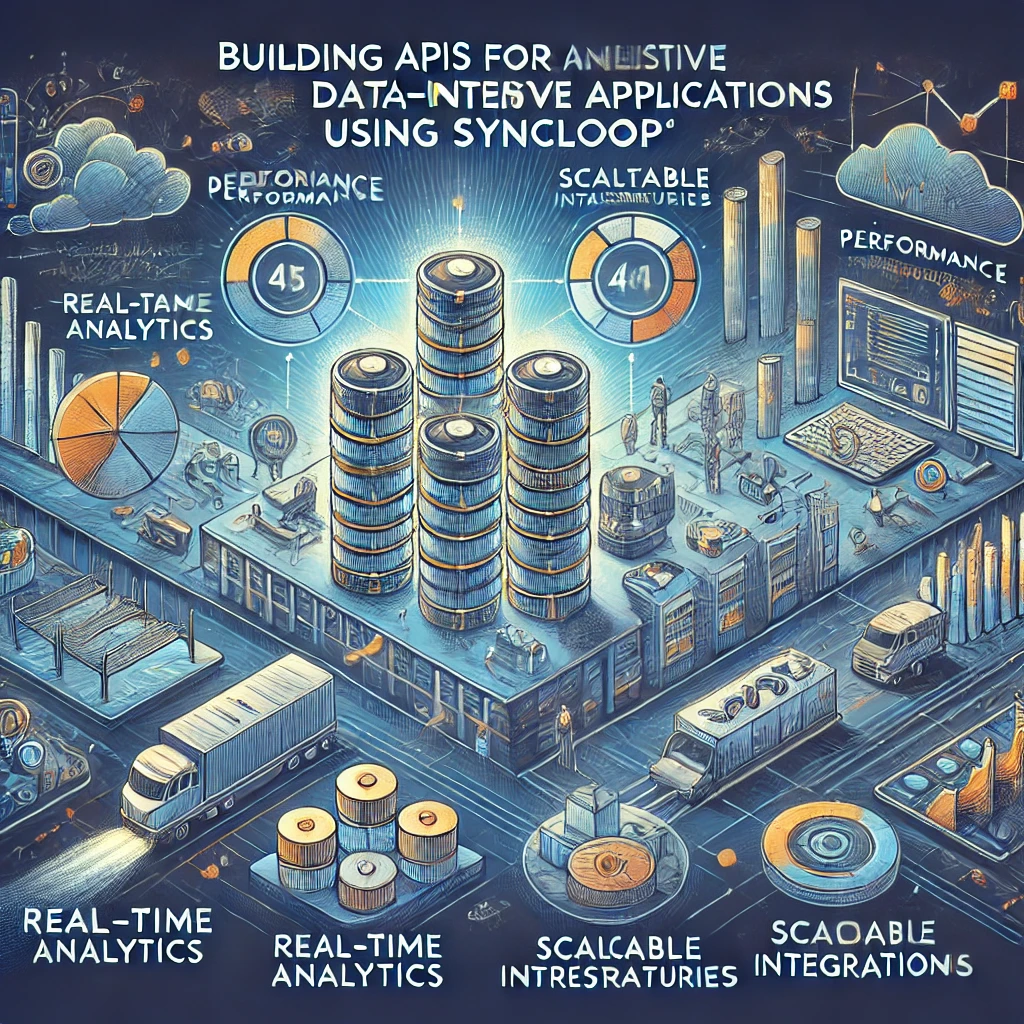Building APIs for Data-Intensive Applications Using Syncloop

Syncloop provides a powerful platform for designing and managing APIs tailored to data-intensive applications. With features that simplify data processing, improve performance, and enhance security, Syncloop enables developers to create APIs that can handle massive data volumes effectively. This blog explores how Syncloop supports data-intensive API development and best practices for optimizing API performance.
Key Challenges in Data-Intensive API Development
- High Data Volumes: Managing and processing large datasets efficiently without affecting performance.
- Scalability: Ensuring APIs can handle growing data demands and user interactions.
- Latency: Minimizing response times for real-time applications.
- Data Security: Protecting sensitive data in transit and at rest.
- Integration: Connecting APIs seamlessly with diverse data sources, including databases, cloud platforms, and third-party services.
How Syncloop Simplifies API Development for Data-Intensive Applications
Syncloop offers robust features tailored to the needs of data-intensive applications:
1. Data Transformation and Mapping
- Simplify complex data processing tasks with Syncloop’s dynamic data transformation tools.
2. Scalable Infrastructure
- Handle large-scale data workloads efficiently with Syncloop’s auto-scaling capabilities.
3. Real-Time Data Processing
- Enable real-time analytics and decision-making with support for WebSocket and REST APIs.
4. Prebuilt Connectors
- Seamlessly integrate with databases, cloud storage, and third-party platforms using Syncloop’s library of connectors.
5. Efficient Caching
- Reduce backend load and improve response times by caching frequently requested data.
6. Advanced Query Optimization
- Optimize API performance with features that streamline complex data queries and reduce processing time.
7. Monitoring and Analytics
- Track API performance, data flows, and usage patterns with Syncloop’s real-time analytics tools.
8. Security Features
- Protect data with encryption, authentication mechanisms, and role-based access control (RBAC).
Benefits of Using Syncloop for Data-Intensive APIs
1. Enhanced Performance
Handle high data volumes and real-time processing demands without compromising speed or reliability.
2. Simplified Integration
Connect seamlessly with diverse data sources and platforms, streamlining development workflows.
3. Scalability
Accommodate growing data and user demands effortlessly with Syncloop’s scalable architecture.
4. Improved Security
Ensure data protection with robust security measures, including encryption and access control.
5. Actionable Insights
Use Syncloop’s monitoring tools to optimize performance and identify potential bottlenecks.
Real-World Applications of Data-Intensive APIs with Syncloop
1. Analytics Platforms
- Process and visualize large datasets in real-time for actionable insights.
2. Machine Learning Pipelines
- Enable seamless data integration and preprocessing for training models at scale.
3. IoT Systems
- Manage vast amounts of device-generated data and deliver real-time analytics.
4. Financial Services
- Handle high-volume transactions, risk analysis, and fraud detection efficiently.
5. E-Commerce Platforms
- Power personalized recommendations, inventory management, and sales analytics with data-driven APIs.
Steps to Build Data-Intensive APIs with Syncloop
Step 1: Identify Data Requirements
- Map out the data sources, volume, and processing needs for your application.
Step 2: Leverage Prebuilt Connectors
- Use Syncloop’s connectors to integrate with databases, cloud services, and third-party platforms.
Step 3: Optimize Data Handling
- Implement caching, query optimization, and data transformation to improve performance.
Step 4: Implement Real-Time Features
- Use WebSocket APIs for applications requiring real-time data updates and processing.
Step 5: Monitor Continuously
- Track API performance and data flows with Syncloop’s analytics dashboards to identify and resolve issues promptly.
Step 6: Secure Data
- Use Syncloop’s encryption and access control features to protect sensitive data and ensure compliance.
Best Practices for Data-Intensive API Development
- Use Efficient Data Models: Design APIs with optimized data structures and formats to minimize processing overhead.
- Implement Caching Strategically: Cache frequently requested data to improve response times and reduce load.
- Optimize Queries: Streamline database queries to avoid performance bottlenecks.
- Scale Dynamically: Use Syncloop’s auto-scaling to handle fluctuations in data volume and user traffic.
- Ensure Security: Protect APIs with encryption, authentication, and access controls.
- Monitor and Optimize: Use real-time analytics to track performance and refine workflows.
Conclusion
Building APIs for data-intensive applications requires a balance of performance, scalability, and security. Syncloop provides the tools and features to meet these challenges, enabling developers to create robust APIs that deliver exceptional results.
Whether managing IoT data, powering analytics platforms, or driving machine learning workflows, Syncloop empowers you to build APIs that handle massive data volumes efficiently. Embrace Syncloop to optimize your data-intensive applications and deliver value at scale.
A conceptual visualization of data-intensive APIs powered by Syncloop, showcasing data flow, caching, and real-time analytics dashboards.
Back to Blogs